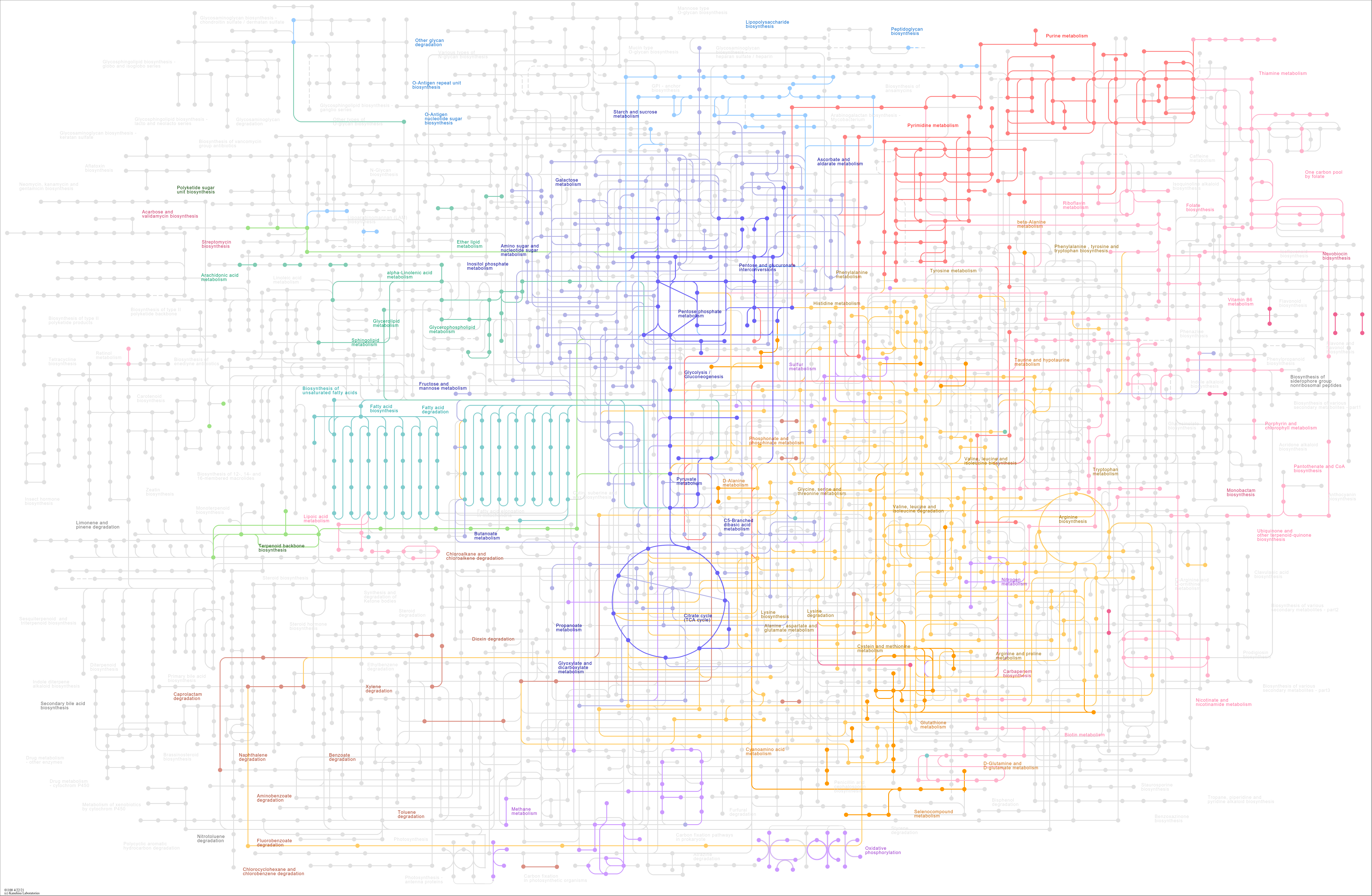Flux Balance Analysis
Flux balance analysis (FBA) is a mathematical approach for analyzing the flow of metabolites through a metabolic network.
Genome-scale Metabolic Network
Metabolism is the set of all biochemical reactions inside a cell, where most reactions are catalyzed by enzymes. Common types of metabolism are:
- conversion of food to energy (ATP),
- conversion of food to proteins, lipids, nucleic acids, ...,
- elimination of wastes.

With the sequencing of complete genomes, it is now possible to reconstruct the network of biochemical reactions in many organisms (including Homo sapiens). From this metabolic network, one can use simulations to make predictions on various interesting properties (e.g., the maximum growth rate of some bacteria in the presence and absence of oxygen).
Metabolic Flux via Mass Balance Equations
From the network, one can derive mass balance equations, which can be expressed as a set of ordinary differential equations.

In this Figure, the model system comprising three metabolites \(A\), \(B\) and \(C\), with three internal fluxes \(v_i\) (including one reversible reaction) and three exchange fluxes \(b_i\).
The mass balance is also presented in this figure, which is defined in terms of the flux through each reaction and the stoichiometry of that reaction. Note that the equations can be represented using a matrix notation; \(S\) is the stoichiometric matrix and \(v\) is the vector of the fluxes.
Furthermore, researchers found that the metabolite concentrations equilibrate fast (~seconds) with respect to the timescale of genetic regulation (~minutes), thus one can safely assume the steady state of mass balance; i.e., \(dS/dt=0\)! Therefore, the mass balance equation is simplyfied into \(Sv=0\).
However, notice that the flux balance equation is underdetermined, since the number of reactions is larger than the number of metabolites. Thus, just solving the equation is not enough; we need more conditions to uniquely determine the meaningful solution.
Convert Balance Equations into Optimization Problem
To identify a physiologically meaningful solution, one can add a biological objective function. This turns the problem into the linear programming (while the objective is linear). Common objective functions are:
- maximization of biomass,
- maximization/minimization of ATP,
- maximization of the rate of synthesis of aparticular product.
We can also add constraints to the optimization problem, so we can reflect some specific biological circumstances, e.g.,
- physico-chemical; conservation of mass, energy, momentum, ...
- environmental; nutrient availability, temperature, ...
- topobiological; molecules are crowded in cells and this constrains their form and function
- regulatory; the gene products made and their activities may be switched on and off
Practical Example: Target Identification of SARS-CoV-2
Renz et al. (2020) reveal a novel potential target of SARS-CoV-2 as follwed:
Generate an integrated host-virus metabolic model by combining
iAB-AMØ-1410; a public model of human alveolar macrohages
virus biomass reactions of SARS-CoV-2, constructed as followed:
- Using the annotated nucleotide sequence of the virus, they calculate the amount of nucleotides, amino acids and energy required by the virus production.
- Then, they collect all metabolisms related to these metabolites to build a custom model.
Identifying candidate reactions from the stoichiometric difference between uninfected vs. infected cells
Use FBA to investigate the actual metabolic changes.
- Objective functions:
- Uninfected: host biomass maintenance
- Infected: total viral molar mass
- Knock-out each reactions in both uninfected and infected cells, and find reactions that do not harm the host cell but disturb the viral growth.
- Guanylate kinase (GK1) reaction is revealed as a promising target
- Objective functions:
Conduct host-derived enforcement analysis
- Based on flux variability analysis
- More possible targets revealed
Find existing drugs in literatures that directly inhibits GK1
References
- Kauffman et al. (Curr. Opin. Biotechnol. 2003). Advances in flux balance analysis.
- Renz et al. (Bioinformatics 2020). FBA reveals guanylate kinase as a potential target for antiviral therapies against SARS-CoV-2.
Author's talk @ ISMB 2020